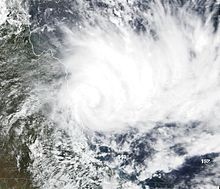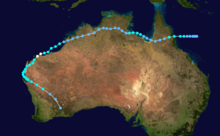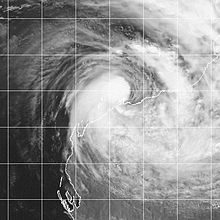- Cyclone Steve
-
Severe Tropical Cyclone Steve Category 3 cyclone (Australian scale) Category 1 cyclone (SSHS) 
Cyclone Steve making its first landfall Formed 27 February 2000 Dissipated 11 March 2000 Highest winds 10-minute sustained:
150 km/h (90 mph)
1-minute sustained:
120 km/h (75 mph)Lowest pressure 975 mbar (hPa; 28.79 inHg) Fatalities None recorded Damage $60.1 million (2000 USD)
($100 million (2000 AUD))Areas affected North Queensland, Northern Territory, Western Australia Part of the 1999–00 Australian region cyclone season Severe Tropical Cyclone Steve was a tropical cyclone that affected northern Australia from 27 February 2000 until 11 March 2000. Cyclone Steve was noted for its longevity and traversal of northern and western Australia. It impacted on regions of northern Queensland, the Northern Territory and Western Australia before clearing to the south of the continent. Steve is the first known Australian cyclone to make four distinct landfalls in the country.[1]
Contents
Meteorological history
A tropical low formed in the Coral Sea to the east of Willis Island on 25 February 2000. The system rapidly intensified to become Tropical Cyclone Steve at around 7am Eastern Standard Time (EST) (UTC+10) on the 27 February 2000. The cyclone crossed the Queensland coast as a Category 2 system on 27 February to the north of Cairns at around 7pm EST. Steve weakened slowly over land and was downgraded to a tropical low on 28 February.
The low tracked westward and re-intensified to tropical cyclone strength over the Gulf of Carpentaria on the same day at around 10pm EST. The cyclone passed over Mornington Island in the southern Gulf of Carpentaria and crossed the Northern Territory coast north of Port McArthur on 1 March as a Category 1. The cyclone weakened back to a tropical low again, but maintained a strong low to middle level circulation as it crossed the base of the Top End of the Northern Territory. The low moved just south of the Joseph Bonaparte Gulf into the Kimberley region of Western Australia and reformed once again into a tropical cyclone just west of Broome on 5 March at 1pm Western Standard Time (WST) (UTC+8).
Cyclone Steve moved in a west southwest direction parallel to the Pilbara coast and strengthened further during the day and was upgraded to a Category 2 system early on 6 March. The cyclone deepened to a pressure of 975 hPa during the day. Continuing on its path to the southwest, Steve passed north of Port Hedland and Karratha on 6 March, before crossing the Pilbara coast near Mardie around midnight on 6 March (Steve's third landfall). The system was again downgraded to Category 1 as it moved inland.
At around midnight on 7 March, Steve again moved offshore about 175 kilometres (109 mi) north of Carnarvon and moved southwards along the coast. However, the system did not intensify further beyond Category 1 and made its final (fourth) landfall at around midnight on 9 March east of Denham. Steve then continued to track to the south-east and increased in speed across southern parts of Western Australia during the 10th and 11 March and becoming extra-tropical, before moving offshore for the final time to the east of Esperance late on 11 March and over the waters of the Great Australian Bight.[2][3]
Impact
Queensland
As Steve tracked inland on the north Queensland coast, it caused major flooding between Cairns and Mareeba. A record flood level of 12.4 m (41 ft) was reached at Mareeba on 28 February 2000. Many buildings in Cairns suffered severe water damage including the Cairns Hospital. Cairns recorded its wettest February on record with the suburb of Manunda measuring 1462.7mm (58 in) and Bartle Frere recording 3376mm (133 in).[1] Wind gusts up to 140 km/h (87 mph) caused several buildings in Cairns and Kuranda to lose their roofs. Hundreds of trees were uprooted and powerlines were brought down throughout the district, disrupting supplies to more than 40,000 residents. In Cairns, a really giant fig tree was uprooted with the entire root system out of the ground. Crop damage by floods and winds was severe, with the sugar cane damage alone estimated at $20 million (AUD). Early estimates indicate that the total damage bill in north Queensland associated with Cyclone Steve may exceed $100 million (AUD).[4]
Northern Territory
Severe winds squalls and heavy rainfall was recorded across the Top End. Several trees were uprooted in Oenpelli which reported winds gusts in excess of 90 km/h (56 mph). Gusts near 90 km/h (56 mph) in Darwin overnight on the 2nd of March brought down trees. Widespread flooding resulted in the Katherine, Daly and Victoria River regions. Water levels in the Katherine River came to within about 3 metres (10 ft) of those experienced in the 1998 floods but fortunately subsided without inundating the town.[1] Rainfall across the Top End, Victoria River region over a four day period between 29 February to 4 March was between 200 and 400 millimetres (8 to 16 inches). Similar totals were recorded over four days in the Kimberley region. Numerous Northern Territory roads and highways were cut with many communities isolated.[4]
Western Australia
Near gale force winds were experienced at Port Hedland for a period of about 17 hours beginning at midnight WST on 5 March. The peak hourly average wind speed recorded was 72 km/h (45 mph) and the maximum gust recorded was 104 km/h (65 mph) (between 8 and 9 am WST 6 March). Winds averaged near 70 km/h (43 mph) at Karratha in the early evening 6 March and the maximum gust recorded was 98 km/h (61 mph) at 6 pm WST.[3]
The very heavy rainfall associated with Steve produced widespread flooding in northern parts of the state, including the Gascoyne region. Communities in the Kimberley region which remained isolated for more than two weeks required food and supply air-drops. Low-lying areas of the Carnarvon townsite were flooded when the Gascoyne River breached its banks. The Gascoyne River at Carnarvon reached its highest level since 1960.
Parts of the western Pilbara and northern Gascoyne received totals that ranged from 200 to 300 mm. Several sites reported highest on record daily rainfall amounts including Mandora (281.0 mm on 6th) and Mount Narryer (152.0 mm on 10th). Carnarvon (100.6 mm on 9th) reported its highest March daily rainfall since records commenced at the airport in 1945.[5] Rainfall ranging from 50 to 100 mm continued over inland parts extending in a south-easterly direction from the west Gascoyne to the south coast near Esperance. Flooding occurred in the Esperance area and number of roads and bridges were washed away. Salmon Gums Research Station recorded 91 mm of rain on the 11th of March.[2]
Retirement
The name Steve was removed from the official list of tropical cyclone names set out by the Tropical Cyclone Warning Centre in Brisbane.[6] It was replaced with the name Stan.[7]
See also
References
- ^ a b c Gary Padgett. "MONTHLY GLOBAL TROPICAL CYCLONE SUMMARY". http://www.australiansevereweather.com/cyclones/2000/summ0003.txt. Retrieved 28 June 2006.
- ^ a b Bureau of Meteorology. "BoM - WA Tropical Cyclone Season Summary 1999-00". Bureau of Meteorology. http://www.bom.gov.au/weather/wa/cyclone/about/seasonsummary199900.shtml. Retrieved 16 June 2006.
- ^ a b Bureau of Meteorology. "Bureau - Tropical Cyclone Steve". Bureau of Meteorology. http://www.bom.gov.au/info/cyclone/steve/index.shtml. Retrieved 16 June 2006.
- ^ a b Bureau of Meteorology. "BoM-Impact from Steve". Bureau of Meteorology. http://www.bom.gov.au/info/cyclone/steve/steve_impacts.shtml. Retrieved 16 June 2006.
- ^ "Climate statistics- Carnarvon Airport". Bureau of Meteorology. http://www.bom.gov.au/climate/averages/tables/cw_006011_All.shtml. Retrieved 2008-08-08.
- ^ Hurricane Alley (2005). "Retired Tropical Cyclone Names". Hurricane Alley Inc. http://www.hurricanealley.net/retired.htm. Retrieved 26 August 2006.
- ^ Bureau of Meteorology (2005). "TROPICAL CYCLONE NAMES". Bureau of Meteorology. http://www.bom.gov.au/catalogue/warnings/cyclone_names.shtml. Retrieved 16 June 2006.
External links
List of retired Australian cyclone names 1960s 1970s 1980s 1990s 2000s 2010s Categories:- Retired Australian region cyclones
- Cyclones in Australia
- 1999–2000 Australian region cyclone season
- 2000 in Australia
- Category 2 Australian region cyclones
Wikimedia Foundation. 2010.


